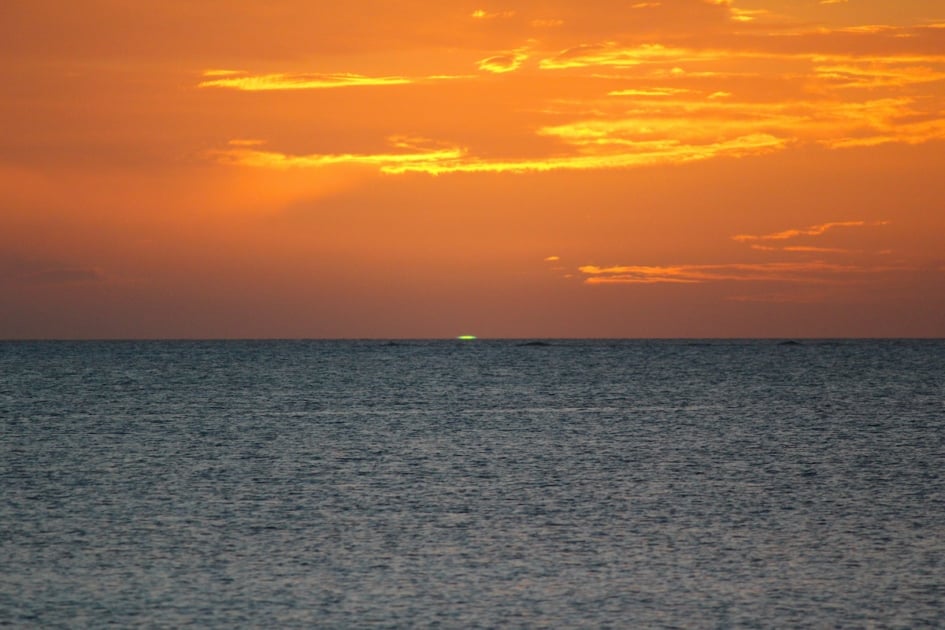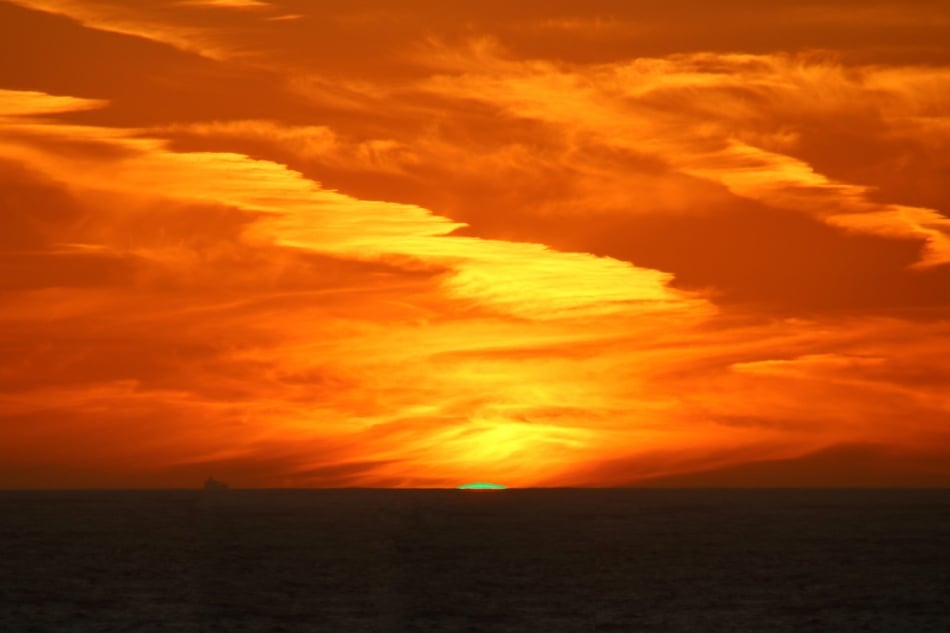The Green Flash: Legends, Lore, and Science Behind The Sunset Phenomenon
The green flash has reached mythical status due to its rarity and unpredictability. Learn how and when to see this elusive optical phenomenon and what causes it.

Not to be confused with the fictional superhero, the “Green Flash,” the solar “green flash” is a natural phenomenon that is just as elusive. For centuries, mariners have shared numerous ominous stories about these magical bursts of green light directly above the Sun as they watched it set on the water. But naysayers have brushed off their stories, claiming them to be a myth. While most pirate’s lore can be chalked up to fantastical fiction, the green flash isn’t. This scarcely seen illusion is a real spectacle, with the science to back it up. So what’s it all about, and how can you see it?
What Is A Green Flash?
A green flash is a phenomenon in which part of the Sun appears to suddenly change to bright green for about 1 or 2 seconds. The brief flash of green light is seen more often at sunset than at sunrise.
What Causes A Green Flash?

So what causes this burst of color? The Earth’s atmosphere acts like a prism, separating sunlight into different colors. A green flash is a result of observing rays through an increasingly thicker atmosphere. As the Sun rises or dips below the horizon, the light bends and is dispersed into the atmosphere. Different colors bend in different amounts depending on their wavelengths. Colors with shorter wavelengths, such as blue, green, and violet, reflect more strongly than colors with longer wavelengths, such as red, orange, and yellow.
When the Sun is higher in the sky, light has a shorter distance to travel and the colors are not well separated. However, as the Sun is dipping below the horizon, the light must travel farther through the atmosphere to meet your eyes. As a result, the colors are more easily split up. When the conditions are exactly right, green wavelengths can reach our eyes, while the other colors are filtered out. This is why we can sometimes see that green flash of light.
Types of Green Flashes
Not all green flashes are the same. There are, in fact, multiple types of them:
- Inferior Mirage: These more common flashes are oval and flat, occurring close to sea level when the water surface is warmer than the air.
- Mock Mirage: These flashes appear in thin, pointy strips, lasting 1-2 seconds and occur higher in the sky when the water surface is colder than the air above.
- Subduct Flashes: This less commonly seen flash occurs due to atmospheric inversion (layer of warm air traps cool air moisture close to the ground). The Sun seems to form an hourglass shape and the upper section of the Sun appears green for upwards of 15 seconds.
- Green Ray: The rarest type of green flash to witness occurs when a beam of green light shoots straight up from the green flash immediately after the Sun sets. This is caused by a combination of hazy air and one of the other three types of flashes.
Where Did The Name Come From?
The green flash’s name may be attributed to French writer, Jules Verne’s 1882 novel, Le Rayon-Vert (The Green Ray), in which the heroine searches for a mysterious phenomenon of unambiguous fascination. Verne describes the color as “a green in which no artist could ever obtain on his palette.”
Green Flash Lore
It is said that once you have seen a green flash, you will never again go wrong in matters of the heart. But if you’re a fan of the “Pirates of the Caribbean” movies, you know that the green flash signifies “a soul [that] comes back to this world from the dead.”
The flash also has its hand in weather lore. An old English proverb claims:
Glimpse you ere the green ray,
Count the morrow a fine day.
This bit of weather lore may remind you of the “Red Sky At Night” proverb in which the color of the sky at sunset foretells the next day’s weather. In this case, a green flash at sunset means the west-facing observer is looking at a clear horizon where tomorrow’s weather will come from (due to the direction of the jet stream), thus the next day’s weather will be “fine.”
How to See a Green Flash
The prospect of observing the elusive flash has become a quest for many. If you find yourself in the optimal location, under the perfect conditions, you may just be a lucky observer of this optical phenomenon. The green flash is most often seen at sunset but it’s also possible to catch it at sunrise as well. However, it is more difficult to view as the Sun comes up as your eyes must be focused on the exact spot on the horizon where the Sun will appear, which is tricky to do.
The green flash has reached mythical status due to its rarity and unpredictability. Unlike other sky shows, such as meteor showers or comets, where scientists can provide advance notice of their occurrence, there is no predicting when you can catch a glimpse of a green flash. Despite its spontaneous and elusive nature, there are ways to improve your chances of catching this fleeting light show.
Under normal conditions, green flashes are so subtle and quick and the intensity of the “flash” is usually too weak to be caught by the human eye. However, if the atmospheric conditions are ideal, the effect can be amplified enough to witness. The best way to ensure a successful observation of the green flash is to make sure you have the following:
- A clear day with no haze or clouds
- An unobstructed view of the horizon with a distinct edge
Green flashes are usually seen over the ocean where more of the atmosphere is visible and the line of sight is parallel to the horizon. But if your horizon is far enough away, they can also be visible on land. Sitting at a higher point can also improve your chances of catching a glimpse. Green flashes are said to be regularly seen from the top of the Empire State building, from mountain tops, and west-traveling aircraft and sunset.
It is important to remember to never look directly at the Sun until it is almost directly below the horizon, or you can risk damaging your eyes.
The Capture A Green Flash on Camera
Luckily, cameras are more capable of detecting the subtle flashes than the human eye. To increase your chances of capturing your own green flash, set your camera up just before sunset on an evening when the horizon is clear and free from clouds and haze. Catching it at sunrise involves more guesswork on where and when the sun will come up, so you may have more luck at sunset.
Tell us: Have you ever witnessed a green flash? Share your story in the comments below.

Natalie LaVolpe
Natalie LaVolpe is a freelance writer and former special education teacher. She is dedicated to healthy living through body and mind. She currently resides on Long Island, New York, with her husband, children, and dog.












I was on an icebreaker up off of Greenland in the summer of 1980 or 81. I was waiting for the sun to set so I could take an azimuth reading on the upper limb when I saw the flash. I anticipated it would last a couple of seconds, but it sat right there on the horizon. It went from blue, to green, to violet, and it was like a diamond sitting there. It then returned to bright green and began to rise. We were at or above the Arctic Circle, so the sun was close to circumpolar; she dipped below the horizon and began to rise immediately.
I was in Kona Hawai’i for the holidays. I was on a beach at sunset and I saw an amazing green flash shoot up from the sky. It was so lovely. I had to ask my friend what it was and he told me about the green flash and how rare it was. I also saw Kailuea erupt that same visit. I feel very fortunate to see two rare events during my stay.
I just seen the green flash in KS about 2 hours ago! Thought I might be going crazy for a second
Ohhhh! You are lucky! That is on our bucket list!
Last night driving home from the SOFLO Boat show in Miami FL. My daughter and I saw an amazing green blue explosion like light that lit up the whole sky and my niece was also in the car but she didn’t see it … might of been looking at her phone at the moment… but me and my daughter were in amazement …. yep it was like a 1 to 2 second beautiful lighting .. so I searched it up and this is what I found … it was a really amazing beautiful color 💚💙
While living in Key West, FL i tried for 3 months to catch it at sunrise AND sunset. 3 months. its easy to see at sunset, but at sunrise, you cant tell exactly when the sun is about to peek over the horizon. blink and you missed it.. *shrug*
That makes a lot of sense that sunset would be easier! Thank you for sharing!
I capture it all the time.
I saw the green flash about five years ago while on our usual weeks holiday in Bude. We watch the sunset every night the weather allows. It was a brilliant experience, for a split second a marvelous Green diamond flash!
How lucky!!
I am disappointed. I thought it would be more like a small lightening strike. Oh well, better luck next time.
Years ago visiting San Diego and seeing the Pacific Ocean for the first time..watching the sunset which was so beautiful..I saw a lime green flash of color appear for just a second on the horizon, next to the sun. Had I blinked, I would have missed it. The other couple people with me didn’t see it—that’s how brief it was. Seeing it felt really special.
I saw one tonight at San Onofre State Park, Surf Beach!